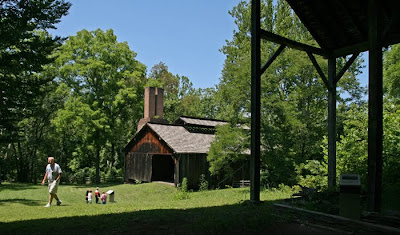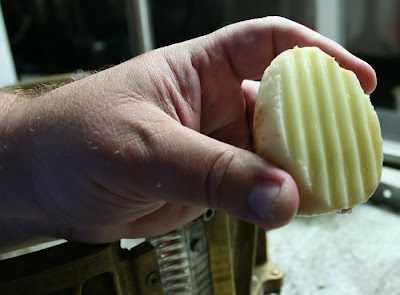The very top of the multi-storied furnace structure (called the charging house) is shown in the top photo as seen from inside the nearby storage shed. Raw materials were moved from the storage shed into the charging house where the process of making molten iron began.
The raw material would become molten and flow down through the furnace into the casting shed (the front end of the structure in the lower photo) where it would be cast in the sand molds into pig iron. Many authentic supplies of the period are shown on display in the interior of the reconstructed company store (small photo below).
THE BUCKEYE FURNACE—
of Jackson County, OH
Today’s story takes a peek at one of only three restored, charcoal furnace locations in the US; this one in the hills of southern Ohio.
These “furnaces” produced pig-iron and were the industrial forerunners of today’s steel industry.
This furnace and 68 other such sites comprised the “Hanging Rock” iron region that extended through southeastern Ohio and northern Kentucky. Iron making began here in the 1830s and ultimately provided Union forces with a vital material for the Civil War effort.
The iron used in the Union ship “Monitor” came from a furnace in nearby Oak Hill, Ohio.
These furnaces were located here because of the readily available raw material; large forests to produce the charcoal fuel to fire the furnaces, the iron ore itself, and limestone which made the flux that purified the molten iron.
The phrase “pig iron” comes from the shape of the molds used to make the iron ingots. The molten iron was poured into a branching structure of sand molds with a configuration similar to the appearance of a litter of suckling piglets.
Usually a small community was born at the location of these furnaces. They often had populations of 300 to 400 folks and were self sufficient.
The furnace company owned everything in the pig iron producing community including the housing and the company store (right). Workers rented or bought everything from the company usually with inflated prices. Purchases often were made with “scrip” or company money.
Often a worker would find his “scrip” was insufficient to pay his bills to the firm. Years later this was lamented in a song made famous by Tennessee Ernie Ford, “I owe my soul to the company store.”
“This industry prospered during and shortly after the Civil War,” according to the Ohio Historical Society. “But, as America began expanding its industrial strength it became plain a different method of making iron had to be found.”
"As new technology emerged the demand for charcoal-produced iron waned. The result was the swift demise of this once vibrant industry."
Mark Meinzer does some photo work in the interior of the casting shed above while Don Karger does likewise in the lower view which is looking through the casting shed toward the lower front of the furnace building.
The large round object in the right of the lower photo is the slag wheel. A chain extended from this wheel to the molten iron that was being poured. A man would walk up the pegs shown extending horizontally from the wheel, causing it to turn, pulling the chain and the slag impurities from the iron and away from the casting where it would cool and be discarded.


































